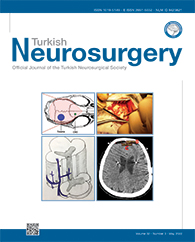2Yuksek Ihtisas Hospital, Department of Neurosurgery, Kirikkale, Turkey
3Istanbul University-Cerrahpasa, Cerrahpasa Medical Faculty, Department of Neurology, Istanbul, Turkey
4Istanbul University-Cerrahpasa, Cerrahpasa Medical Faculty, Medical Student, Istanbul, Turkey DOI : 10.5137/1019-5149.JTN.33806-21.2 AIM: To present one of the largest retrospective cavernoma related epilepsy (CRE) studies which include divergent supratentorial locations operated and followed up at least 2 years. We also investigated the factors affecting the seizure outcome.
MATERIAL and METHODS: This study includes a total of 56 patients with drug-responsive (n=40) and drug-resistant (n=16) CRE who underwent resective surgery. Age at seizure onset, age at surgery, gender, duration of epilepsy, seizure frequencies/type before and after treatment, EEG and brain MRI findings, prescribed AEDs, preoperative and post-operative neurological status, histopathological diagnosis, post-operative seizure outcomes and surgical information were documented.
RESULTS: The average follow-up period was 69.6 months (range 24-216 months). The seizure outcome was assessed according to Engel?s classification at the last follow-up. Engel class I was achieved in 53 patients (95%); there was one patient at class II and two patients at class III. All patients in the drug-responsive group were at Engel class I after the surgery, while all patients at Engel classes II and III were in the drug-resistant patient group. This clearly shows that there were better outcomes in DRP group (p<0.01). Neither the locations of cavernomas nor the duration of epilepsy had any impact on seizure outcome (p>0.05).
CONCLUSION: An earlier surgical intervention may prevent the patients from becoming drug-resistant such that their chances of being seizure free after surgery increase.
Keywords : Epilepsy, Cavernous malformation, Cavernoma, Epilepsy surgery, Drug resistant epilepsy




